Are you looking for a fun, challenging, and active way to spend time together as a family? Want to help your kids develop problem-solving skills, boost their confidence, and increase their concentration? Then rock climbing might just be your new favorite family activity! Today, youth climbing coach and Washington mom of 4, RyAnn Peverly shares everything you need to know to get started rock climbing with your kids. She’ll go over all the gear you need (or don’t need), rock climbing terminology, the types of climbing you can try, and practical advice (from a mom) for rock climbing with kids.
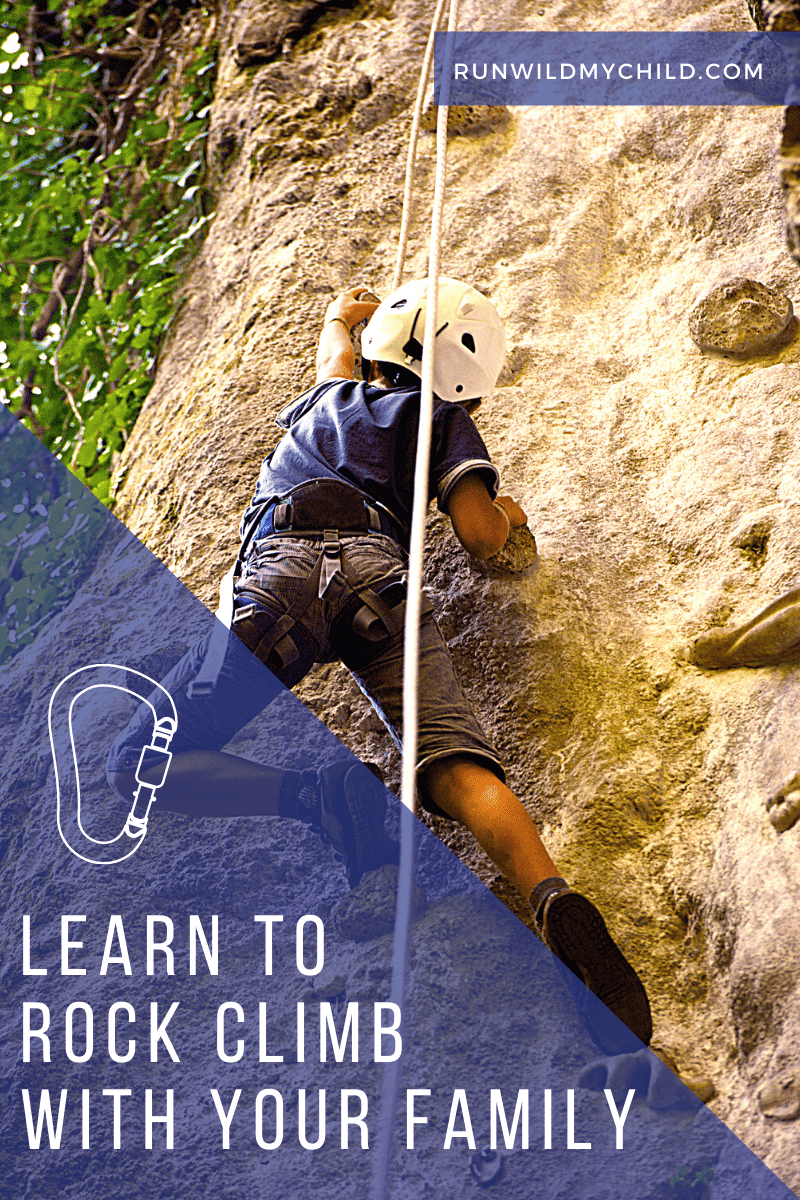
A climbing adventure
A few years ago, I was perusing a shop in one of our favorite mountain towns and came across a shirt with the quote “Adventure is a Family Value” written across the front. While that shirt has long since been put away (thanks to many kid-caused stains), the quote is something I adopted in my heart and still live by to this day.
Part of adopting that motto meant trying new things and sharing those experiences with my kids. And one of the best new things we started doing as a family was rock climbing. I’m so excited to share this fun activity with you in the hopes of convincing you to give it a try with your kids!
Benefits of rock climbing for kids
Rock climbing is a great activity for families to try together. There are so many great benefits of rock climbing for young kids. It helps teach problem-solving and decision-making skills. It’s great for working on communication and building/establishing trust with one another. Plus, we all know the benefits of staying active, playing together, and spending time OFF screens.
Climbing is also a great sport for both younger kids and older kids. Climbing helps them with eye-hand coordination, gross motor skills, and body awareness. It is an activity that engages every major muscle group and requires the climber to pay attention to how they are moving their body. Rock climbing helps kids build courage, confidence, and self-esteem, as well as increases their concentration, focus, physical fitness, and patience. It helps with agility, endurance, speed, concentration, flexibility, and perseverance.
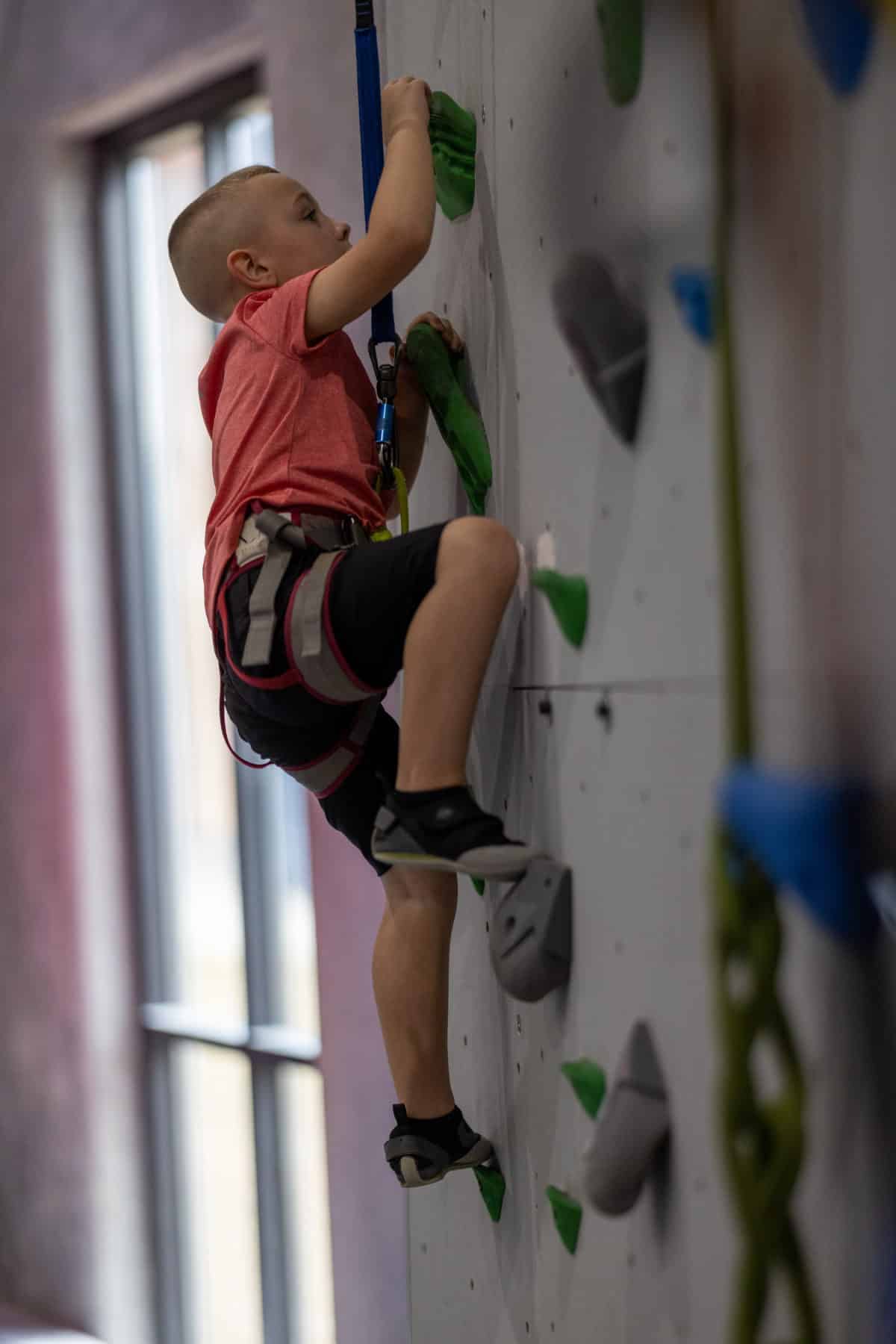
Best age to start rock climbing for kids
The good news is that there’s no magic age for learning how to rock climb. You can learn at any age (adults included). Most climbing gyms will have a minimum age of 5 years old, but depending on your child and the type of climbing they’re doing, some places allow kids as young as 2 to give it a try. The requirement to be 5 is more about the child being mature enough to listen and follow instructions, more than them being “ready” to climb. Climbing comes a lot more naturally to young children and requires less upper body strength for little bodies, so starting them early gives them a good jump start over starting as an adult.
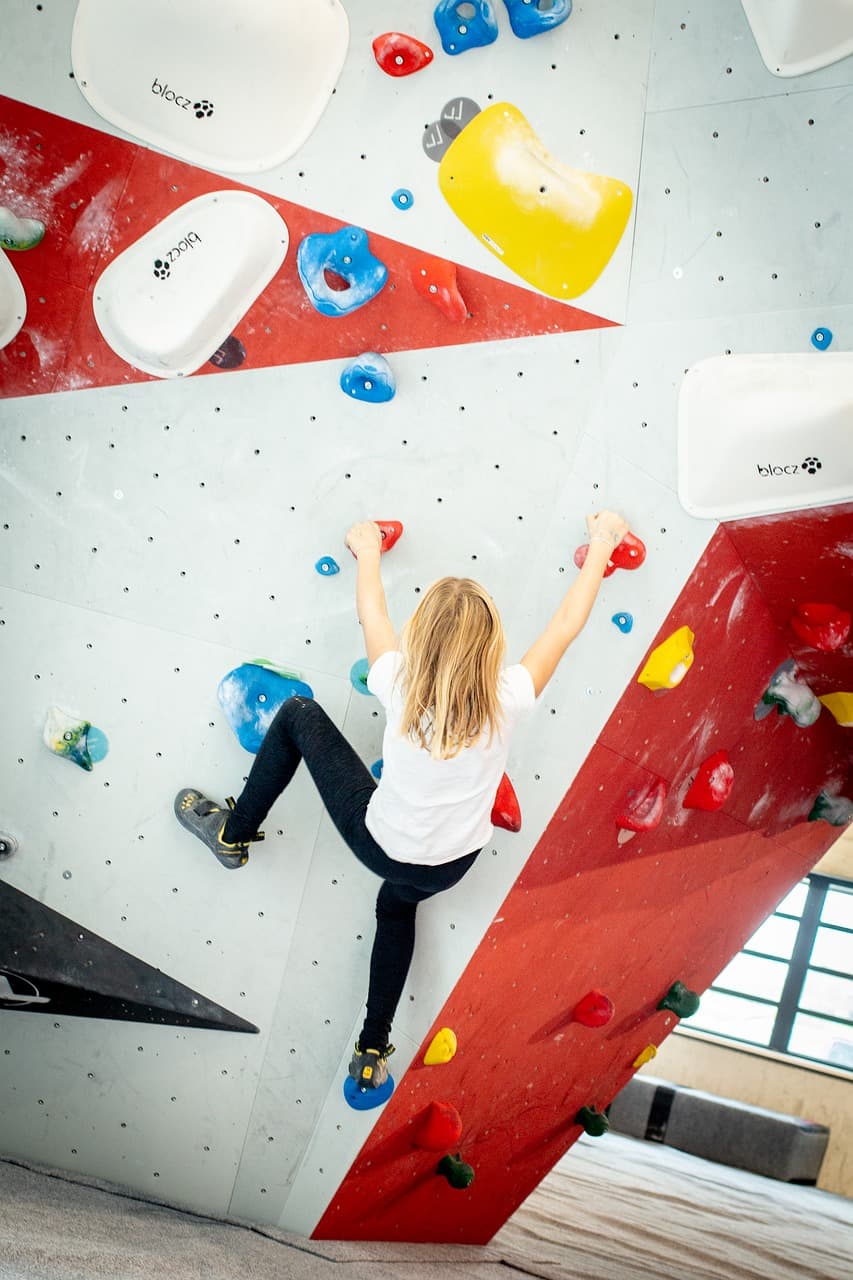
Types of rock climbing for kids
There are several different types of rock climbing, and understanding the difference can help you know what type of gear you will need and where to start. For kids and adults that have never been rock climbing before, bouldering or top-rope climbing is a great place to begin.
Bouldering
Bouldering is climbing in its simplest form and is great to kick off with. When bouldering, you leave behind ropes and harnesses and just climb (sometimes using climbing shoes, chalk, and safety mats). The point of bouldering is to climb short but tricky routes or sequences using balance, technique, strength, and your brain. You have to problem-solve on the fly. You don’t need experience, much instruction, or lots of expensive gear, making it really easy to get into if you’ve never tried it before. Bouldering climbs are enough to be exciting, but most routes are easy to jump off of or climb down from, so they’re not super intimidating or scary for kids. Many indoor climbing gyms offer a variety of bouldering walls.
Top rope
This type of climbing is the most popular setup for beginners both in climbing gyms and outdoors. Top rope climbing is what most people imagine when they think of climbing. Top roping is when the climbing rope is anchored to a spot at the top of the route. The climber then climbs toward the anchor while their partner keeps the rope taut, known as belaying. Top roping is a great option for beginners because it is safer than other types of climbing and requires a lot less knowledge for beginners. New climbers really only need to know one knot and bring along one person who can belay. It allows new climbers to get a feel for rock climbing without many risks.
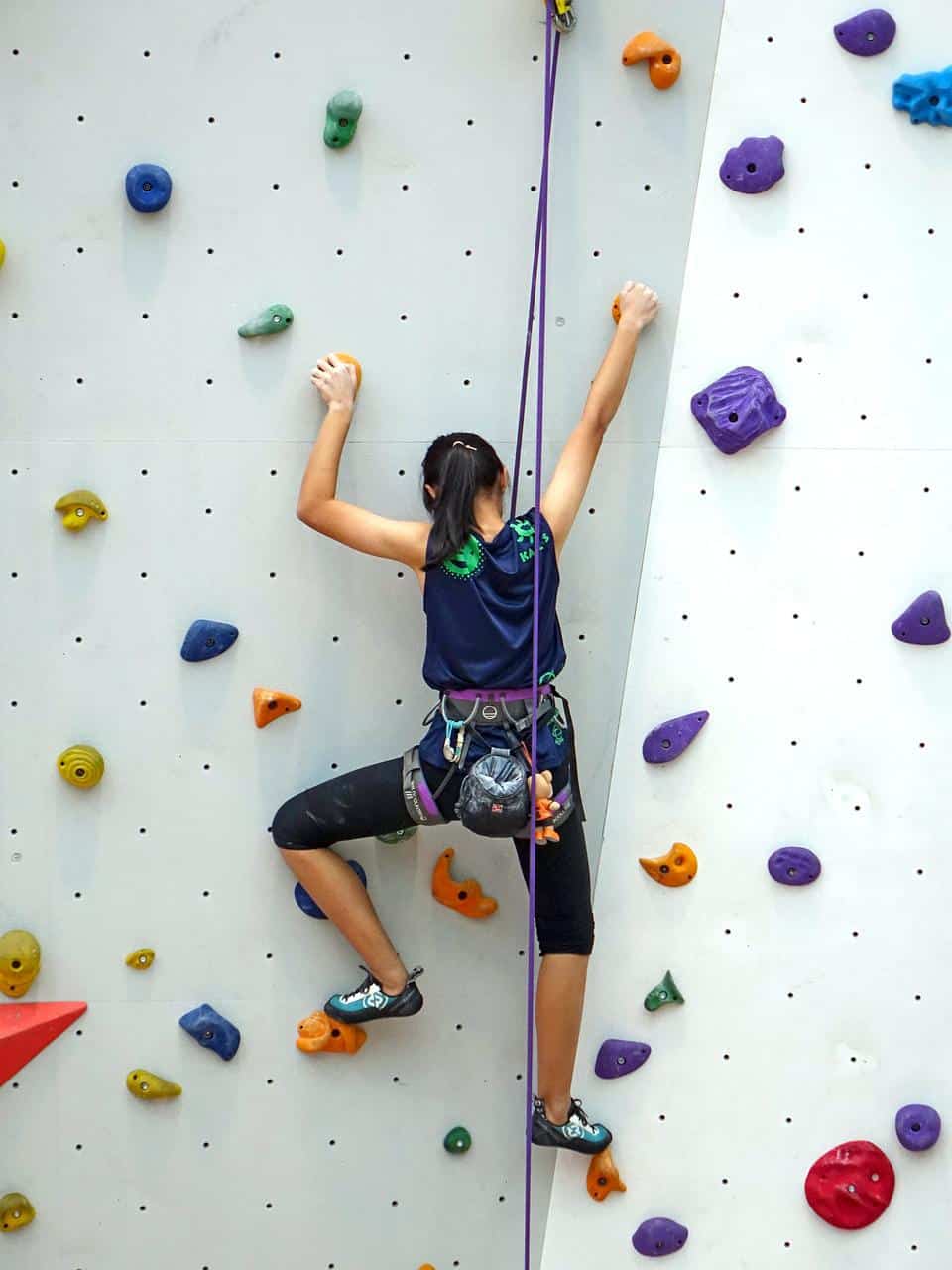
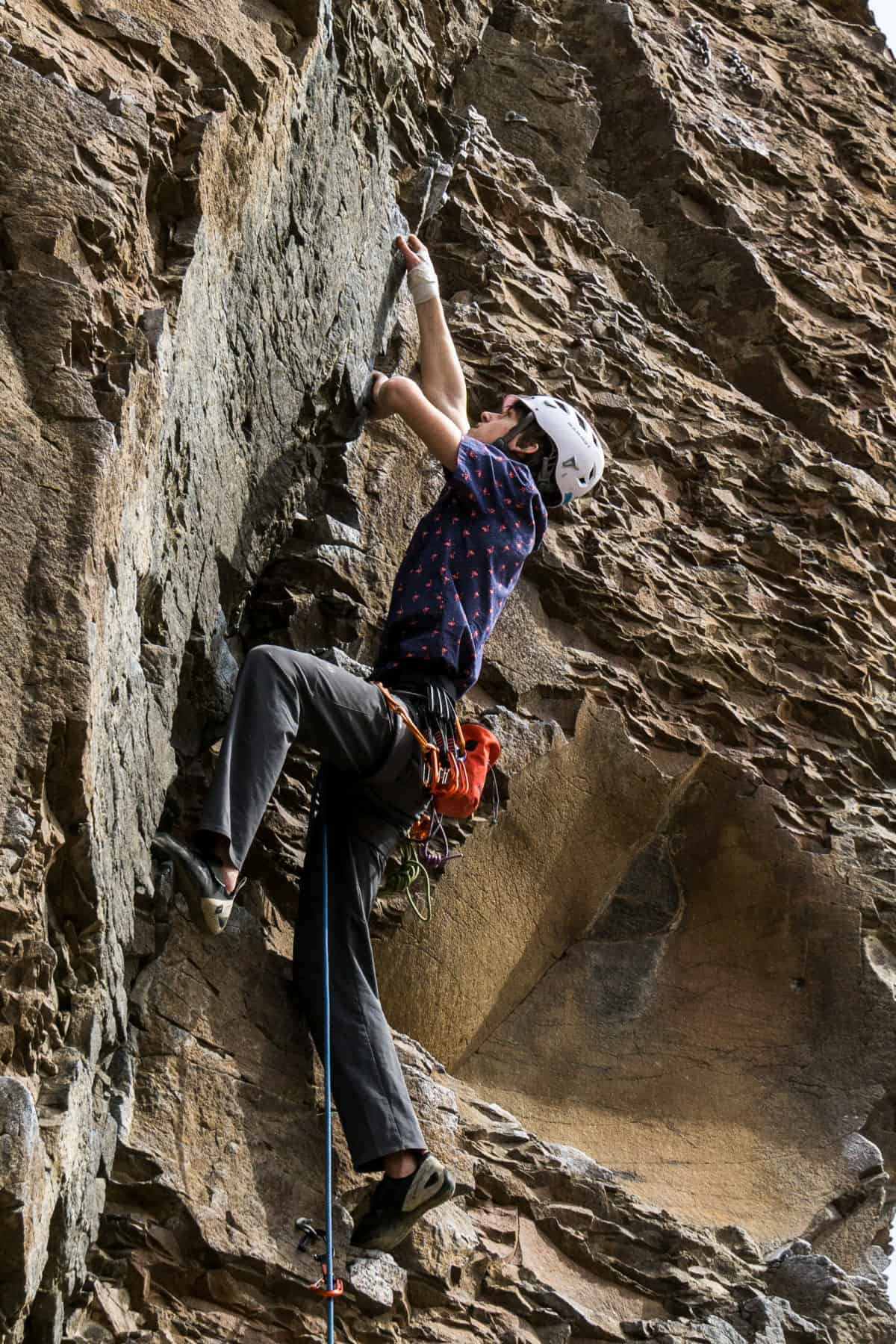
Taking your rock climbing skills to the next level
If climbing becomes a sport your family wants to get more involved with, there are always opportunities to progress and advance your skills. Whether that’s in ain indoor rock climbing gym setting or taking your skills outdoors on your own! Beyond bouldering and top-roping, there is sport and traditional climbing, both of which involve lead climbing and setting up routes on your own. For both of these types of rock climbing, you’ll need more advanced training, a bit more gear, and lots of practice.
Sport climbing
The first type of lead climbing that most people learn is sport climbing. Sport climbing is climbing using fixed protection for safety. The climber wears a harness and is tied to a rope which is managed by a belayer below. The climber clips the rope into bolts that are pre-drilled while climbing. For this, we use “quickdraws” to clip into the bolts with hangers as you progress higher on the wall.
Traditional climbing
Traditional climbing, also known as “trad” climbing, is the most advanced of all types of rock climbing. This form requires the climber to use specialized gear that is placed in natural cracks and holes in the rock for protection. Trad climbing requires you to learn how to place this gear in a way that the gear can safely catch a belayed fall, but it can also be removed when done with the climb.
If you are interested in learning these more advanced forms of climbing, I always suggest taking a clinic or hiring a professional to teach you these skills before going out on your own.
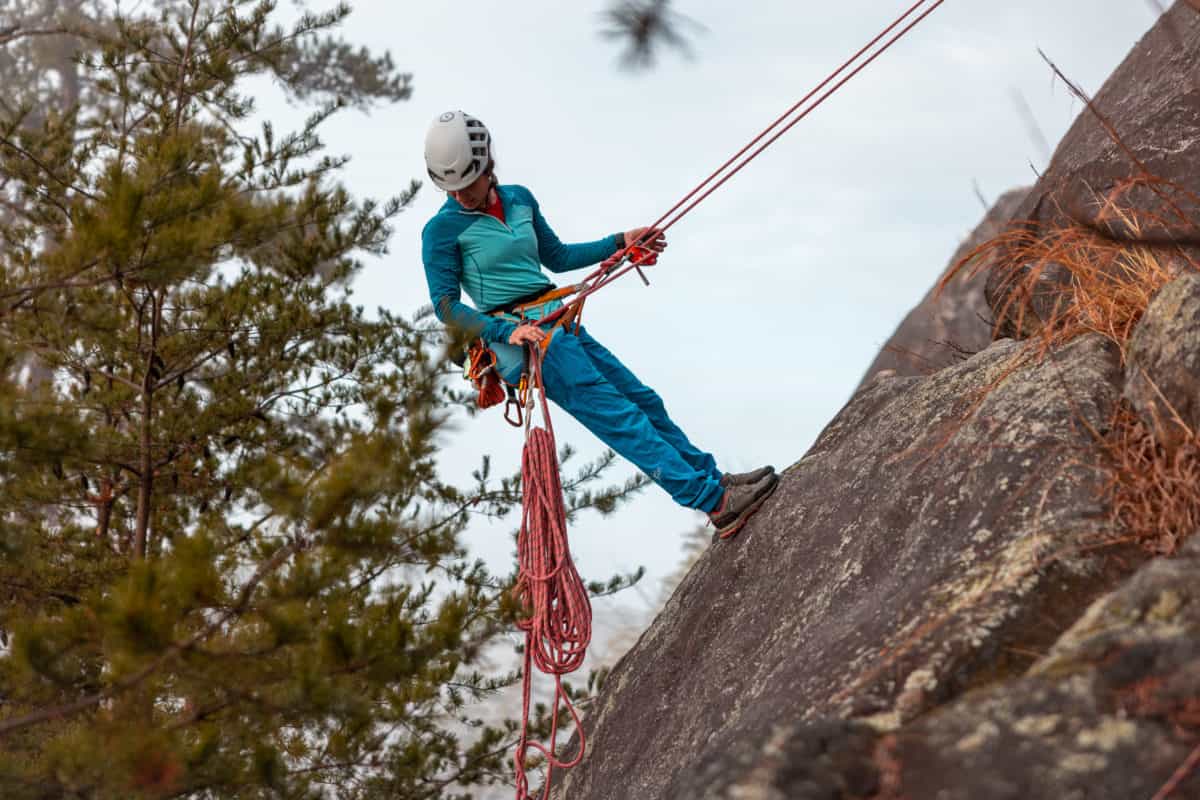
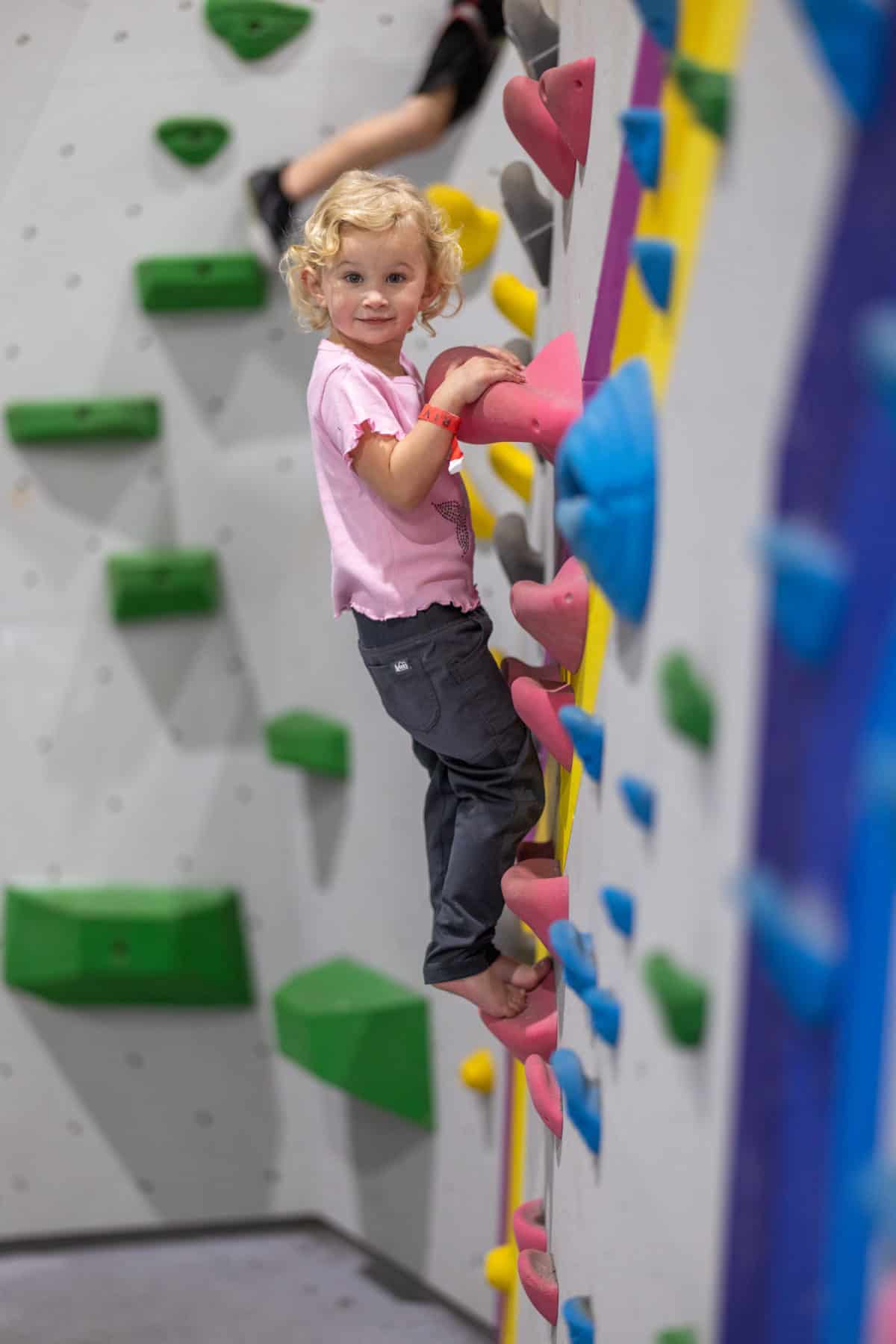
Where to get started rocking climbing
After deciding which type of climbing most interests your family, the next step is finding the right location to begin your training. The best ways to get started are either at a local indoor climbing gym or with a certified guide.
Climbing gym
Getting started in a climbing gym is probably the easiest and most economical way to learn how to rock climb. Climbing gyms are a great place to get started from the beginning as they generally have both bouldering and top-rope climbing areas so that you can test out both styles in a controlled environment. Climbing gyms also provide a supportive environment filled with climbers that are willing to help with advice and tips. They also offer gear rentals which makes it a low-cost commitment to try out while you decide if this is something you’d like to continue before investing in gear.
The best way to start in a climbing gym is to take an orientation or an “Intro to Climbing” class. These rocking climbing classes offer new climbers an understanding of how the systems and styles work. Although bouldering is relatively easy to start on your own, top-roping requires learning how to tie into a rope as the climber, and how to manage the rope as a belayer. An Intro class will teach you the various types of climbing skills on the indoor climbing walls so that your family can enjoy all a climbing gym has to offer.
Check out the Indoor Climbing website to find a climbing gym close to you. Many indoor climbing gyms offer youth programs or youth discounts for young climbers. They may also offer day camps, summer camps, birthday parties, open gym time, kids’ activities, games, school programs, themed day events, competitive youth teams, and other ways to make climbing fun and social for kids.
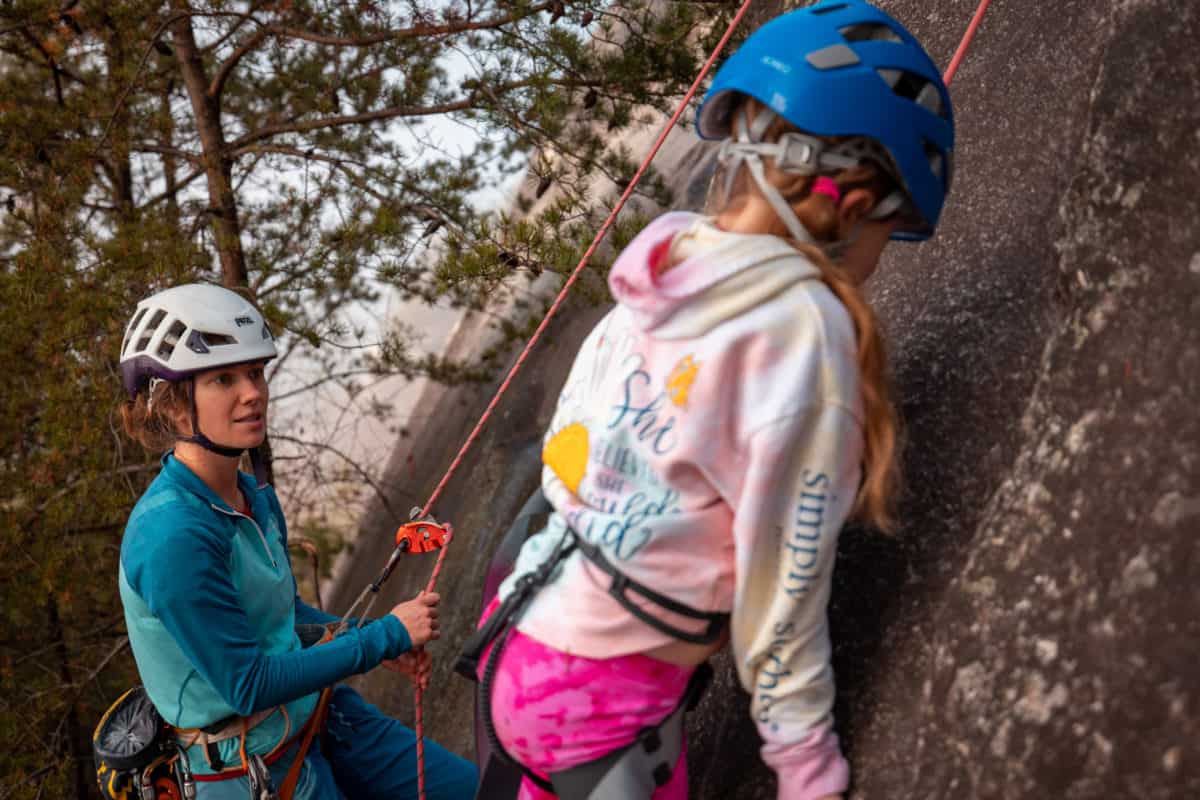
Rock climbing outdoors with a guide
If you want to take the adventure outdoors, the best way to go about this is to hire a certified rock climbing guide. Outdoor climbing can be a risky sport, so learning from an experienced guide is highly recommended to provide for a safer environment. When you hire a rock climbing guide, you will get personalized instruction, and most guides have gear for you to use while out for the day.
When considering a rock climbing guide, look for an AMGA-Accredited guiding business. The American Mountain Guides Association is a nationally recognized organization that provides guides with the training they need to lead others in outdoor pursuits safely. In order for a business to become certified by the AMGA, it must commit to the highest standard of safety and professionalism.
Here is an example of two certified businesses:
Climbing terms you should know
Whether you get started in a gym or with a guide outside, you will likely hear other climbers and your guide use some words you’re not familiar with. As with most sports, climbing has its own language. Getting a head start on some of the terminology can help in understanding this sport in a better way.
- Belaying: Using a piece of gear, called a belay device, to control the amount of rope going to a climber and to arrest a fall. The person belaying is called the belayer.
- Route: Common term for a particular path to climb, either on a natural rock face or gym wall.
- Boulder problem: Instead of “route,” the word “problem” is often used when referring to bouldering rather than roped climbing.
- Pitch: A segment of a rock climbing route for which one rope length is used. Most outdoor rock climbs are one pitch.
- Multi-pitch: A route of more than one pitch, which requires resetting the rope progressively higher up the wall as climbers ascend. (advanced climbing)
- Anchor: A point (or set of points) where gear is secured to fasten the rope and hold a fall.
- Crag: An outdoor rock climbing destination, typically one that consists of many different single-pitch climbs.
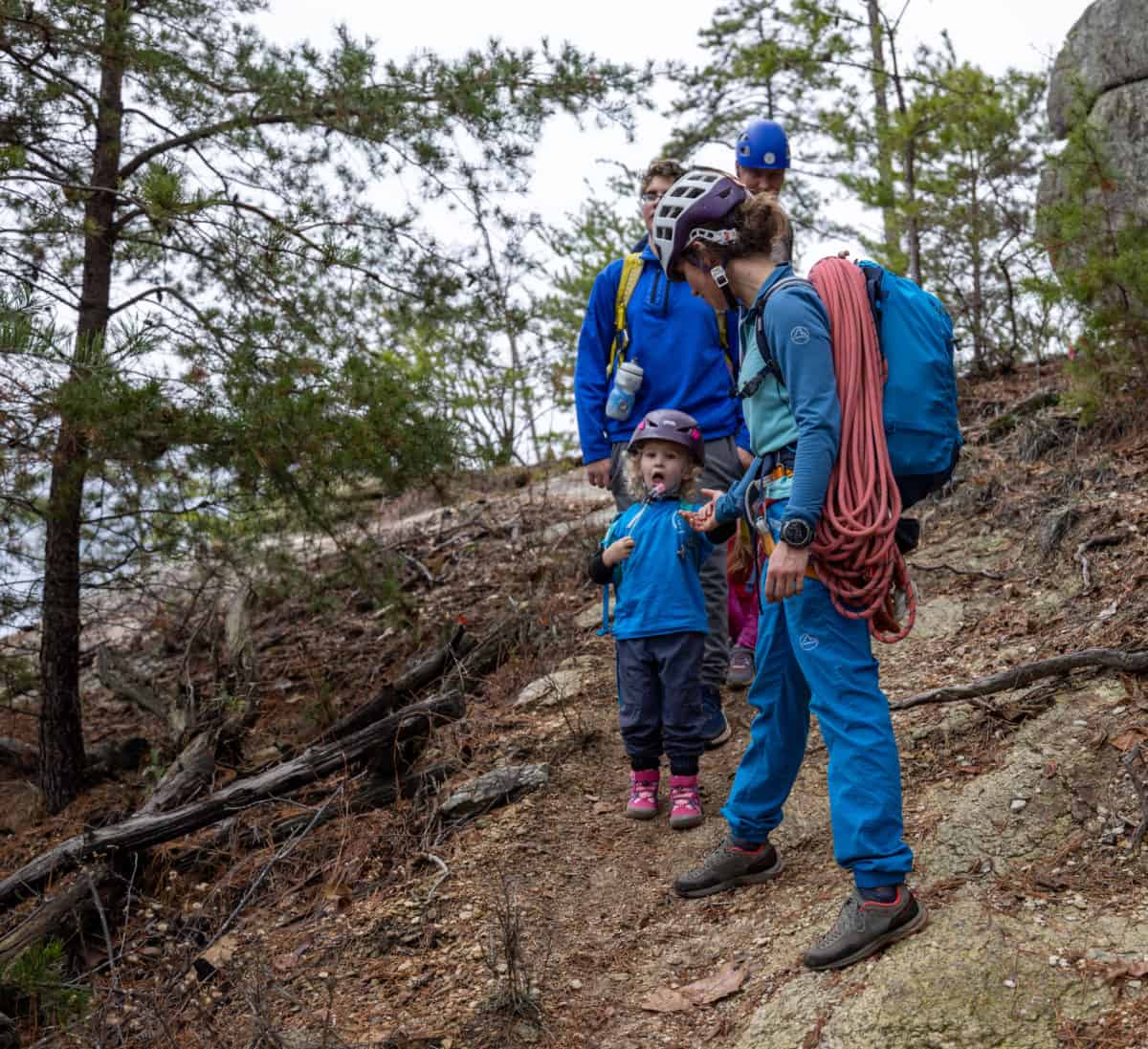
Rock climbing gear for kids
Like with most outdoor adventure sports, climbing gear can come with a hefty price tag. But do not be dismayed! When starting out, rock climbing gyms and guides will have the gear you need to get started. And depending on what type of climbing your family is interested in, one or two key pieces of gear are probably all you need. As your family develops more skills, you can start to invest in what makes the most sense for you.
When people ask me what gear they should invest in first, I always say a good pair of climbing shoes and a harness. Yes, most gyms and guides generally have rentals, but if climbing is a sport your family finds they really love, those rental fees can add up after a while.
- Shoes: A good pair of climbing shoes will fit snugly and provide the friction needed to grip holds while climbing. There are lots of styles, so it is best to go try them on at a retailer to see what shoe fits best.
- Harness: If you are climbing with ropes, you will need a harness. The harness allows you to tie into the climbing system safely. Harnesses consist of two main components; a waist belt and leg loops. This is another piece of gear that is worth trying on before you buy.
- Helmet: When climbing outdoors, a helmet should always be worn. Helmets are designed to protect your head from possible falling debris and if a climber falls. Climbing helmets should fit snugly and comfortably, like a bike helmet.
- Chalk & chalk bag: Climbers use chalk to help with grip while on the wall. The chalk helps to absorb any perspiration on your hands so they’re not slick. Chalk is carried in chalk bags attached to the back of a harness. 8BPLUS makes fun chalk bags my kids love.
- Crash pad: If you are going to take bouldering outside, these are a must-have item. Crash pads are made of dense foam and placed under a climber to protect their fall. Plus, they make a great nap spot for tired little climbers.
- Carabiners: Strong, metal rings with a spring-loaded gate that are used to connect rope and other gear. The first carabiner that you purchase will most likely be for use with a belay device.
- Belay device: The belay device is an essential piece of gear that you will need the more you get into climbing. Most gyms and guides will have some for use, but this may be something to add to the purchase list early on. The belay device is used by the belayer to control the rope. These devices allow the belayer to take in slack created by a climber, and let out rope to safely lower a climber.
- Ropes: There are lots of different ropes on the market, but when just getting started, there is really only one type of rope that is necessary. Rock climbing ropes need to be dynamic, meaning they have enough stretch to absorb the energy of a fall. I always recommend speaking with a professional before purchasing your first rope.
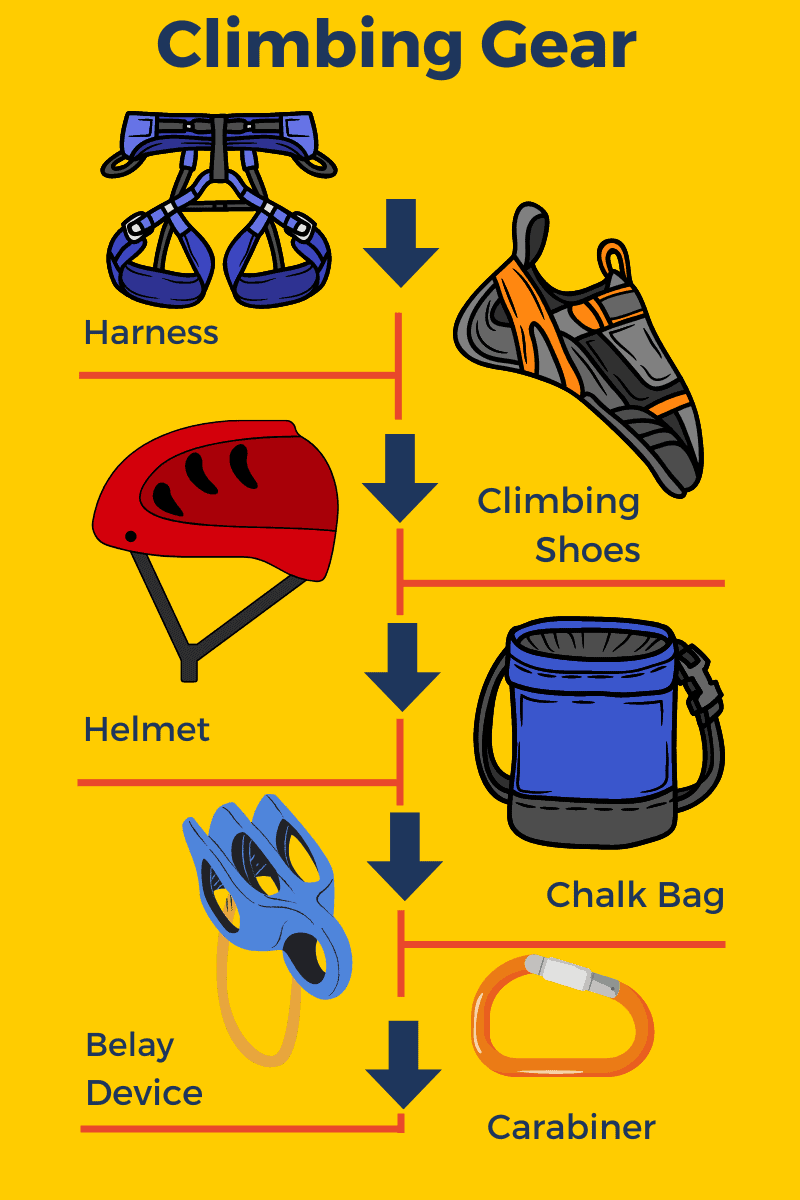
Practical advice for rock climbing with kids
Now that our family has been climbing together for a while now, I’ve learned a few things that keep us successful, whether we are at the gym or spending a weekend camping and climbing at a local crag. Here’s my most practical advice for parents when just getting started rock climbing with kids.
Start small
The first time you go rock climbing may not be the grand adventure you were expecting. Your first few times will be a lot of instruction, outfitting, familiarizing yourself with the gear, and trial and error. Those first few times trying, kids will learn how it feels to be in a harness, the names and usage of equipment and climbing commands, how it feels to tackle different climbing holds, how to rappel with proper form, and trust the belayer and equipment to protect them from falls. That’s a lot! And may not leave a lot of time for the actual climbing.
The first time we all went to the gym together, I thought we would be there for at least two hours. We left a little after 20 minutes. Everyone climbed one route, and then they were tired and done. It was small, but it was a start. Sometimes, that’s enough.
Lower your expectations
Lower your expectations for your rock climbing with kids experience. Now lower them again! While almost all kids climb something in their daily lives (think kitchen cabinets, furniture, trees in the yard, playground jungle gym), that does not always mean they will jump on the wall and climb to the top. As a youth climbing instructor, I have seen many kids freeze as soon as they tie into a rope, and not climb more than three feet off the ground. That’s ok! They are getting comfortable with new gear and a new environment. Go into your rock climbing adventure with zero expectation, and maybe your child will surprise you!
Bring snacks (and entertainment)
As with all of our adventures, I never leave home without an arsenal of favorite snacks. Sometimes taking a break to enjoy a favorite treat or energizing granola bar can be just the motivation they need to try again. Climbing can take a lot out of your kids, so keeping them fed and hydrated is key to keeping them happy and focused. Also, because rock climbing usually requires 2 people working together at a time (one climber and one belayer), if you have more than one kid, bring along entertainment for your younger kids to do while others climb.
Be positive
Sending a route does not have to be the only measurement of a successful climbing day. Work together as a family to choose what you’re going to climb. Let the kids help in any part of the process that is safe. And, if all they want to do is climb a few feet up the wall and swing, then let them swing! Keep your attitude positive and supportive. Encourage your kids to climb, but don’t push them beyond their comfort zone. Let them decide what they feel comfortable with. Every time you go rock climbing with your kids, you increase their exposure to the sport, and they get more experience. But most importantly, you spent time together.
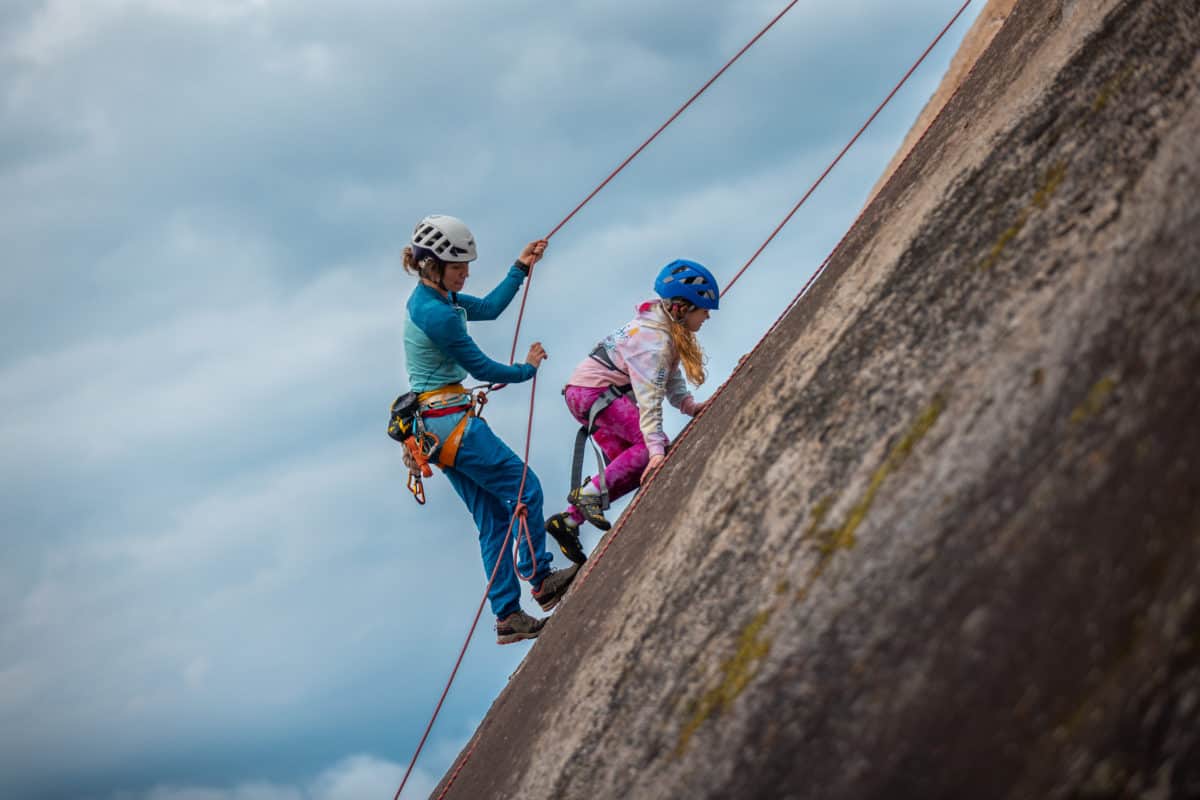
* Thank you to Pisgah Climbing School for providing pictures.
Rock climbing with kids
I hope this post has inspired you to give rock climbing with kids a try! It’s such a great sport for children of all ages (and parents) and a perfect way to spend time together doing something active, challenging, and fun! Next time you’re looking for something fun for the whole family to do, check out the options and availability at your local climbing gym and give it a try! Or sign your little climber up for one of the many climbing camps offered at a climbing gym this summer. We hope your kids will learn to climb to new heights this year!
Have your kids tried rock climbing?

About the author
RyAnn is a mom of four (20, 18, 15, 6) that loves exploring her home in the Pacific Northwest. She works as a youth outdoor program instructor for the Mountaineers Org. in Washington state. RyAnn also loves getting out and adventuring with her family as much as possible. They enjoy traveling around the PNW in their converted Sprinter campervan. On her days off she generally loads up the van and hits the trails for hiking, mountain biking, skiing, or climbing. RyAnn is passionate about instilling love and respect for outdoor spaces in her kids and the youth she is lucky to work with.
You can find more from RyAnn in the following locations:
Instagram: @mountain_mama4
Website: Mountain Mama
RWMC articles: RyAnn

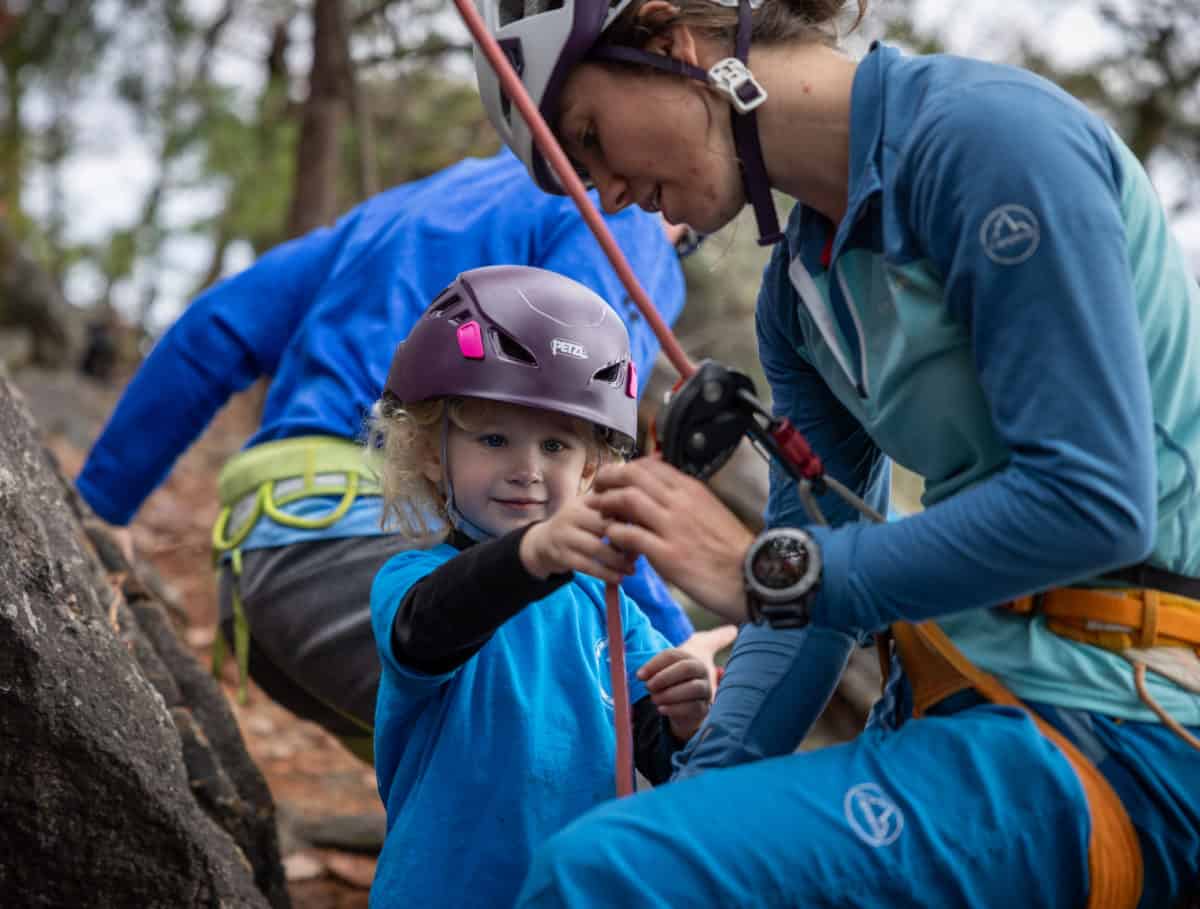







Great article with lots of info to get kids out climbing!